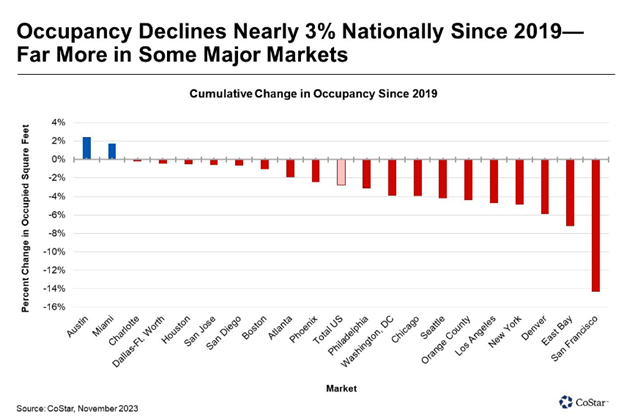Hybrid work has left many offices empty. Some cities have fared better than others.
When the Covid-19 pandemic brought the world to a halt, it seemed the two-week experiment would remain temporary, until those two weeks turned into months and created a new way of working for employees once required to be in the office daily. The hybrid/remote work environment remains strong, and highly desirable for employees. Return to office mandates have failed to increase office-utilization rates for most office markets in the United States, and the levels of those in office on any given day are still 30-40% lower then 2019 levels.
Employers have begun adjusting their office needs based on the hybrid work models they follow, sending office vacancy rates and space available for lease to historic highs for many major U.S. cities. Some cities have been hit harder than others, and it’s time for property owners to begin asking what they can do with their property to adjust to the new normal.
Coastal U.S. markets felt the impacts of hybrid work earlier on, such as New York or San Francisco where the things that made these cities great and thrive ceased to exist under lockdown orders. The southeast, meanwhile, mainly sunbelt cities, saw higher levels of in-migration and job growth helping to offset reduced demand for office space. Cities like Charlotte, Miami, and Nashville are not off the hook though, as office space is a problem for them. A large amount of new office developments in these areas have come online in recent years, adding more vacant space.
San Francisco has seen the worst of the office market slow down. Many of the city’s office tenants are in the tech industry, which has been consistently more open to welcoming hybrid or fully remote work environments for employees. Additionally, many tech workers are seeing lay offs resulting in less office space needing to be leased. San Francisco now has an availability rate greater than 30%, the highest in the country.
New York has started to bounce back after several years of office demand disruption, though there remains more vacant space than before Covid. The city has a diverse economy with several large financial services present, and the finance industry has been more adamant of employees returning to the office.
The main question the office sector now faces is what to do with all the unused inventory? Converting office space to other uses, such as office-to-residential conversions is a first thought for many. Housing shortages and affordability are plaguing many big cities. The conversion of these properties is not as simple as It sounds. For starters, there are structural differences in office and multi-family developments and unless and office is fully torn down, conversion can be nearly impossible. Additionally, developers can face zoning challenges when attempting to change use from commercial to residential.
Municipalities continue to attempt changing zoning regulations to allow conversions, but there is a cost hurdle that may not be enough for a developer or investor to overcome in the absence of government incentives. These conversions may occur marginally, but they will not start a movement for housing or cause a significant reduction in office inventory for several years.
On the bright side, newer office space with modern amenities are facing more demand then lower quality buildings, since companies seek to provide employees with attractive alternatives to working from home. Owners who invest in modernizing space could see more space occupied versus those who do not.
Occupancy losses in the United States show that the office market is in a generational shift of demand. Negative demand has happened before, in 2001 and in the beginning of 2009. It took six quarters for both cases, for the abandoned space to be reabsorbed into the market. From the second quarter if 2020 through 2021 tenants said goodbye to over 133 million square feet of office space. Since 2022’s second quarter, 71 million square feet of space has been added to that number. By the end of 2023, the nations office market will have seen a 3% decline in occupancy – around 200 million square feet. Only two of the nation’s 20 largest office markets have avoided a loss of occupancy – Austin and Miami.

Trends point to more negative absorption to be on the way. Nationally, should the historical quarterly average of 17 million square feet of positive absorption resume at the beginning of 2024, it would still take three years to recover the occupancy lost since 2020 and an additional 18 months to return to the equilibrium vacancy rate of 10.9%.

Source: CoStar, Wall Street Journal
Thank you for your interest. If you are in need of Appraisal & Valuation services in the West Central Florida Market, contact:
Mike Cliggitt, MAI, MRICS, CCIM
813.405.1705 | 863.661.1165 - Direct Lines
SHARE CONTENT





